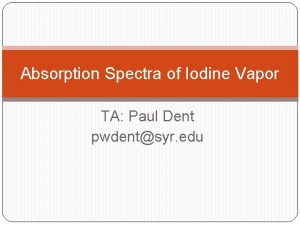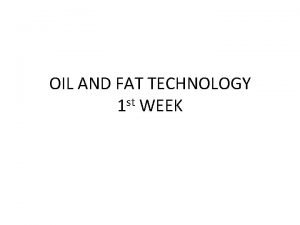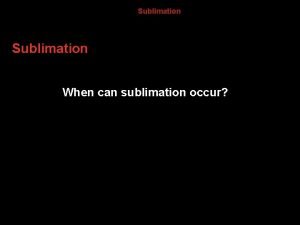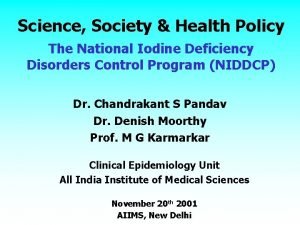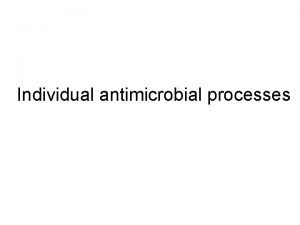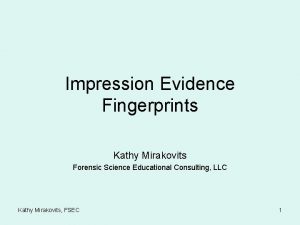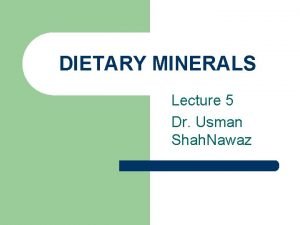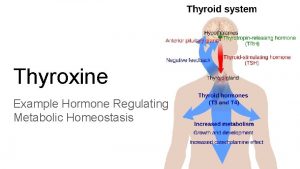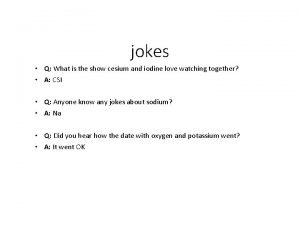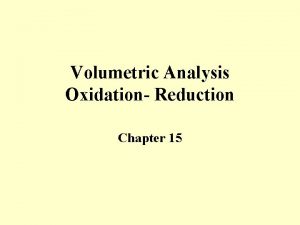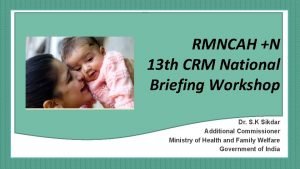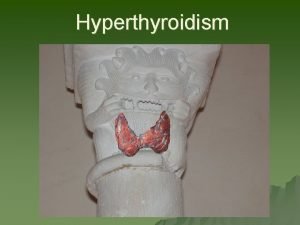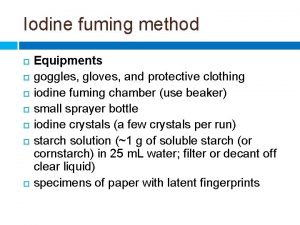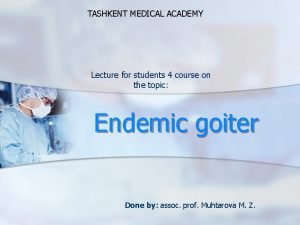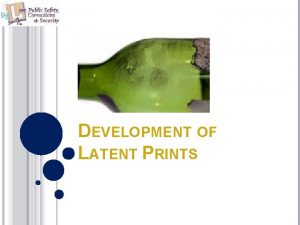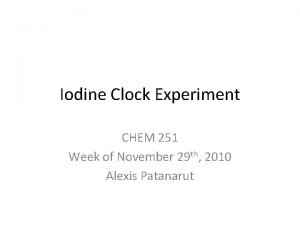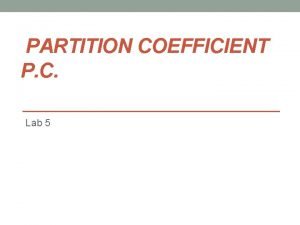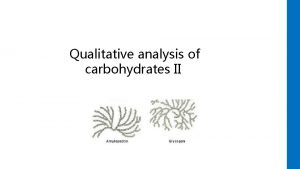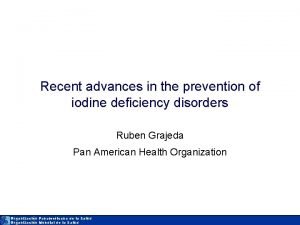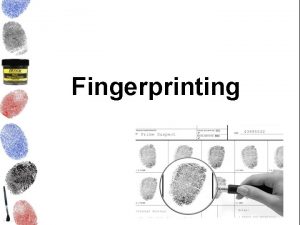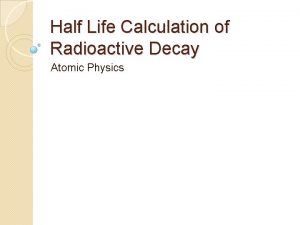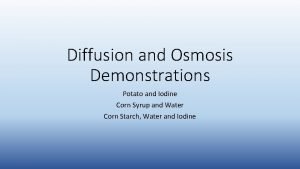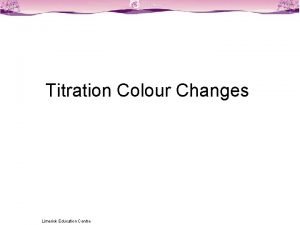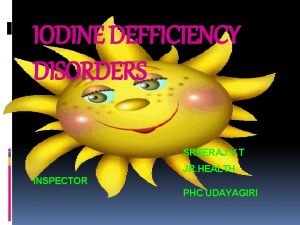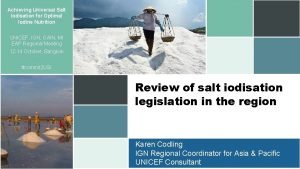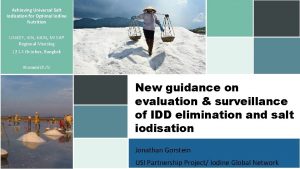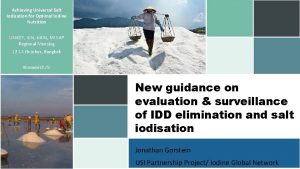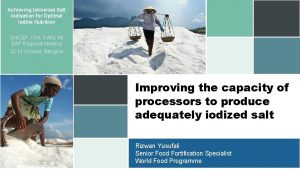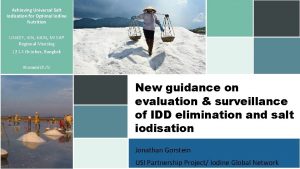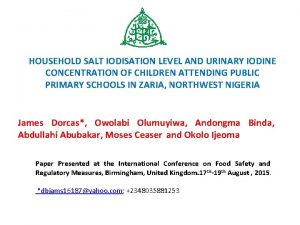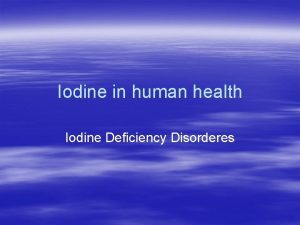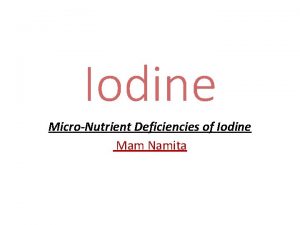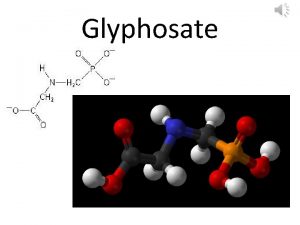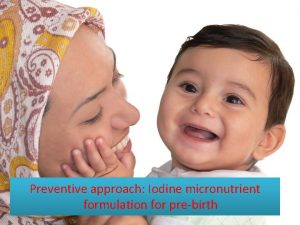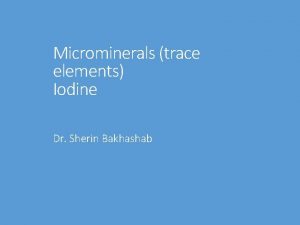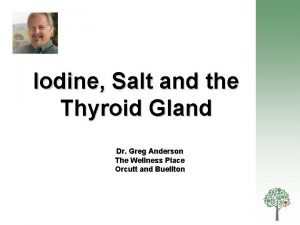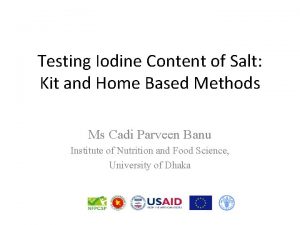Achieving Universal Salt Iodisation for Optimal Iodine Nutrition



































- Slides: 35

Achieving Universal Salt Iodisation for Optimal Iodine Nutrition UNICEF, IGN, GAIN, MI EAP Regional Meeting 12 -14 October, Bangkok #commit 2 USI Changing landscape of IDD elimination and emerging questions Roland Kupka UNICEF Headquarters - New York

OVERVIEW Background Salt iodization and iodine status Equity Salt iodization in wider nutrition programs Sodium intake and non-communicable chronic diseases Global architecture on salt iodization Program challenges Conclusion 12 -14 October 2015 Bangkok 2

1993 110 countries iodine deficient 12 -14 October 2015 Bangkok

2015 Severe Moderate Mild Adequate Excess No data 25 countries iodine deficient 12 -14 October 2015 Bangkok

IODINE STATUS OF UK SCHOOLGIRLS: A CROSS-SECTIONAL SURVEY mild moderate severe 12 -14 October 2015 Bangkok Our findings suggest that the UK is iodine deficient Vanderpump, Lancet 2011 Published online June 2, 2011 DOI: 10. 1016/S 0140 -6736(11)60693 -4

IODINE DEFICIENCY DISORDERS ARE THE MOST COMMON PREVENTABLE CAUSE OF MENTAL IMPAIRMENT GLOBALLY Poor cognitive development Poor school performance Lowered earning capacity 12 -14 October 2015 Bangkok

EACH DOLLAR INVESTED IN SALT IODIZATION RETURNS $30 IN BENEFITS 12 -14 October 2015 Bangkok EAP Regional Workshop on ACHIEVING UNIVERSAL SALT IODISATION FOR OPTIMAL IODINE NUTRITION 7

OVERVIEW Background Salt iodization and iodine status Equity Salt iodization in wider nutrition programs Sodium intake and non-communicable chronic diseases Global architecture on salt iodization Program challenges Conclusion 12 -14 October 2015 Bangkok 8

MAJOR MILESTONES FOR ELIMINATION OF IODINE DEFICIENCY 12 -14 October 2015 Bangkok 9 UNICEF, 2008

All food-grade salt, used in household and food processing should be fortified with iodine as a safe and effective strategy for the prevention and control of iodine deficiency disorders in populations living in stable and emergency settings (strong recommendation) 12 -14 October 2015 Bangkok World Health Organization, 2014

SALT IS OFTEN AMONG THE FEW VEHICLES THAT REACH POOR HOUSEHOLDS In many countries in the region, salty condiments, such as soy sauce and fish sauce, and pickled vegetables are consumed by all segments of the population. China: High consumption of salt and salty condiments reaches all population groups independent of socioeconomic status Du et al, Am J Clin Nutr. 2014; 99: 334– 343 12 -14 October 2015 Bangkok EAP Regional Workshop on ACHIEVING UNIVERSAL SALT IODISATION FOR OPTIMAL IODINE NUTRITION 11

SALT IODIZATION- ORIGINAL PARADIGM Coverage of Adequately Iodized Salt at Household (HHIS) Iodine Status (Urinary Iodine – UIC among school-aged children) Program sustainability factors 12 -14 October 2015 Bangkok 12

SALT CONSUMPTION UNITED STATES Most salt is consumed through processed and restaurant foods (and mostly invisible) Mattes RD, et al. J AM Coll Nutr 1991; 10: 383– 393 12 -14 October 2015 Bangkok

FNB, vol. 33, no. 4 (supplement) 2012 FNB, vol. 34, no. 2 (supplement) 2013 12 -14 October 2015 Bangkok

NEW PARADIGM: OPTIMIZE IODINE NUTRITION THROUGH DIFFERENT DIETARY SOURCES OF IODINE Iodized salt remains at the core of IDD control efforts Household Adequately Iodized Salt Other targeted MN interventions (home fortification, maternal 12 -14 October 2015 supplements. . ) Bangkok Iodized Salt in Processed Foods & Condiments fd National Iodine Status (Urinary Iodine) Iodine in soil & water (affects iodine in local drinking water & agricultural products) Program sustainability factors 15

OVERVIEW Background Salt iodization and iodine status Equity Salt iodization in wider nutrition programs Sodium intake and non-communicable chronic diseases Global architecture on salt iodization Program challenges Conclusion 12 -14 October 2015 Bangkok 16

PERCENTAGE OF HOUSEHOLDS CONSUMING ADEQUATELY IODIZED SALT 2009 -2013 75% Globally <20% 20 -49% 50 -69% 70 -89% ≥ 90% Data not presented as most recent estimate is not in accordance to the standard definition and earlier data <2009 no data 12 -14 October 2015 Bangkok Source: UNICEF Database, 2015

INEQUITIES BETWEEN THE RICHEST AND POOREST QUINTILES IN CONSUMPTION OF IODIZED SALT ARE EVIDENT IN ABOUT TWO THIRDS OF COUNTRIES Household iodized salt coverage Highest quintile Coverage lowest quintile << Coverage highest quintile 12 -14 October 2015 Bangkok Coverage lowest quintile= Coverage highest quintile Household iodized salt coverage Lowest quintile

OVERVIEW Background Salt iodization and iodine status Equity Salt iodization in wider nutrition programs Sodium intake and non-communicable chronic diseases Global architecture on salt iodization Program challenges Conclusion 12 -14 October 2015 Bangkok 19

AT NATIONAL LEVELS, INTEGRATION OF SALT IODIZATION PROGRAMS IN THE EFFORTS RELATED TO WIDER NUTRITION PROGRAMS WILL BE CRUCIAL 12 -14 October 2015 Bangkok

SALT IODIZATION PROGRAMS HAVE SUCCESSFULLY MAINTAINED MULTI-STAKEHOLDER COALITIONS AND MAY THEREFORE HAVE A LOGICAL ‘FIT’ WITH SUN EFFORTS SUN multi-stakeholder platforms and networks Multi-stakeholder platform Country government Donors Civil Society FP T i s u B 12 -14 October 2015 Bangkok UN Agencie s s s ne Co ec m hni m ca un l ity

OVERVIEW Background Salt iodization and iodine status Equity Salt iodization in wider nutrition programs Sodium intake and non-communicable chronic diseases Global architecture on salt iodization Program challenges Conclusion 12 -14 October 2015 Bangkok 22

SALT INTAKE AND NONCOMMUNICABLE DISEASES Noncommunicable diseases (NCDs) are a major contributor to mortality and morbidity globally Elevated sodium intake has been associated with a number of NCDs (including hypertension, cardiovascular disease and stroke), and decreasing sodium intake may reduce blood pressure and the risk of associated NCDs WHO recommends a reduction in sodium intake to reduce blood pressure and risk of cardiovascular disease, stroke and coronary heart disease in adults. WHO recommends a reduction to <2 g/day sodium (5 g/day salt) in adults 12 -14 October 2015 Bangkok WHO Guideline : Sodium intake for adults and children. 2012

NATIONAL, REGIONAL, AND GLOBAL SODIUM INTAKE IN 1990 AND 2010: A SYSTEMATIC ANALYSIS OF 247 24 -HOUR URINARY SODIUM EXCRETION STUDIES AND DIETARY SURVEYS WORLDWIDE Mean national sodium intake g/d in adult males in 2010 Recommended upper level of sodium intakes 12 -14 October 2015 Bangkok Fahimi et al. Circulation 2013; 127: A 017

COORDINATED PROGRAMS TO OPTIMIZE SALT AND IODINE INTAKE High sodium intake Iodine deficiency ↑blood pressure→ ↑ heart disease, stroke Related to 30% of hypertension Major cause of mortality worldwide Two billion people at risk Most common cause of preventable mental impairment Salt iodization highly effective prevention strategy Optimizing salt & iodine should be global priority WHO recognizes that salt reduction and salt iodization are compatible In fact, both agendas stand to gain from close coordination and cooperation Suggested actions Achieve consensus on importance of collaboration on optimizing salt and iodine intakes Devise tools and resources to aid in joint planning Compile reliable intake on salt intake and iodine deficiency, esp among vulnerable groups Develop harmonized message: Salt intake should be < 5 g/d, but all salt should be iodized 12 -14 October 2015 Bangkok Campbell et al , Rev Panam Salud Publica 32(4), 2012

OVERVIEW Background Salt iodization and iodine status Equity Salt iodization in wider nutrition programs Sodium intake and non-communicable chronic diseases Global architecture on salt iodization Program challenges Conclusion 12 -14 October 2015 Bangkok 26

THE GLOBAL IODINE ARCHITECTURE HAS BEEN HARMONIZED WITH THE CREATION OF THE IODINE GLOBAL NETWORK (FORMERLY ICCIDD GLOBAL NETWORK) IGN plays a strong scientific and advisory role on iodine nutrition and the network of over 100 regional and national coordinators and partner agencies (GAIN, MI, and UNICEF) are at the core of its activities and global efforts to eliminate IDD. 12 -14 October 2015 Bangkok

OVERVIEW Background Salt iodization and iodine status Equity Salt iodization in wider nutrition programs Sodium intake and non-communicable chronic diseases Global architecture on salt iodization Program challenges Conclusion 12 -14 October 2015 Bangkok 28

PROGRAM CHALLENGES A) COUNTRIES WITH SCALED UP PROGRAMS Optimal iodine nutrition status AND scaled up USI programmes Focus is on consolidation, programme adjustments and on sustaining achievements • How to ensure sustainability (sliding back, periodic oversight, commitment, mainstream iodine nutrition, functional coalition, adjust to changing national context) • Dealing with external threats (media, opponent groups, complacency among policy and programme staff, changes in enabling environment) 12 -14 October 2015 Bangkok 29

PROGRAMME CHALLENGES B) COUNTRIES IN SCALE UP PHASE USI being scaled up with/without optimal iodine status Programme focus on a) improve the % of poorly iodized salt, b) expand capacity to suppliers with no iodization (%) small producers; food industry • • • Capacity (small producers, QA issues, advocacy & communication along supply value chain) Commitment (poor enforcement, illegal non-iodized salt, imported salt, disincentives to iodize salt (e. g. taxation)) Hard to reach population - IS or alternative strategies (subsidized IS, other iodine interventions) 12 -14 October 2015 Bangkok 30

PROGRAMME CHALLENGES C) COUNTRIES WITHOUT POLICY/PLAN TO SCALE UP AND ACHIEVE USI/OPTIMAL IODINE NUTRITION USI not being scaled up; without optimal iodine status Commitment, awareness lacking among gatekeepers (private, public, civic); and/or inadequate capacity • Importance iodine nutrition/USI not recognized by policy makers or health advisers (no monitoring, issue not recognized) • Confusion about presence/form of USI in combination with/without other strategies • Alternative strategies promoted - compete with USI strategy, leading to reduced commitment for USI 12 -14 October 2015 Bangkok 31

PROGRAMME CHALLENGES D) FRAGILE STATES USI (not) achieved with/without optimal iodine status Fragile environment (political, shock due to disasters) erodes USI and sliding iodine status Strategies not in place/weakening; lack of attention, priority • How to ensure USI or alternative interventions are put in place short term • Targeting of population, prioritization of efforts, making optimum use of resources 12 -14 October 2015 Bangkok 32

OVERVIEW Background Salt iodization and iodine status Equity Salt iodization in wider nutrition programs Sodium intake and non-communicable chronic diseases Global architecture on salt iodization Programme challenges Conclusion 12 -14 October 2015 Bangkok 33

CONCLUSION • Salt iodization is one of the biggest public health success stories in the last two decades and remains highly relevant despite changes in programming landscape • However, a quarter of the world’s population remains at risk for low iodine intakes and the job is thus not yet done • IDD prevention efforts need to remain a cornerstone of global nutrition agenda The control of iodine deficiency in all countries worldwide by 2020 is within our reach! 12 -14 October 2015 Bangkok 34

Thank you! #commit 2 USI
 Absorption spectrum of iodine
Absorption spectrum of iodine Iodine value formula
Iodine value formula Iodine sublimation temperature
Iodine sublimation temperature National iodine deficiency disorders control programme
National iodine deficiency disorders control programme Advantage of
Advantage of Iodine fuming
Iodine fuming Iodine test for starch
Iodine test for starch Lifting fingerprints with super glue
Lifting fingerprints with super glue Iodine functions
Iodine functions Heyoka dns
Heyoka dns Iodine deficiency
Iodine deficiency What is the show cesium and iodine love watching together?
What is the show cesium and iodine love watching together? Cellulose in iodine test
Cellulose in iodine test Sodium thiosulfate and sodium hypochlorite reaction
Sodium thiosulfate and sodium hypochlorite reaction Orbital diagram for ca
Orbital diagram for ca Iodine deficiency control programme
Iodine deficiency control programme Data exfiltration over dns
Data exfiltration over dns Carbimasole
Carbimasole Iodine fuming chamber
Iodine fuming chamber Iodine deficiency goiter
Iodine deficiency goiter Iodine fuming definition
Iodine fuming definition Iodine fuming
Iodine fuming Disadvantages of iodine fuming
Disadvantages of iodine fuming Iodine clock reaction lab report answers
Iodine clock reaction lab report answers Iodine partition coefficient
Iodine partition coefficient Iodine test for starch
Iodine test for starch Iodine deficiency
Iodine deficiency Halogen triad
Halogen triad Plastic fingerprints
Plastic fingerprints Radioactive decay of iodine 131
Radioactive decay of iodine 131 Potato and iodine diffusion experiment
Potato and iodine diffusion experiment Crystal violet iodine alcohol safranin
Crystal violet iodine alcohol safranin Iodine is an example of a/an_____.
Iodine is an example of a/an_____. Difference between reducing and non reducing sugars
Difference between reducing and non reducing sugars Starch indicator
Starch indicator Daily iodine requirement
Daily iodine requirement
